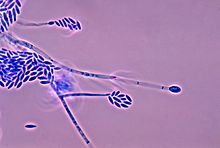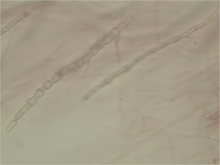Fusarium
| Fusarium | |
|---|---|

| |
| Fusarium verticillioides | |
| Scientific classification | |
| Domain: | Eukaryota |
| Kingdom: | Fungi |
| Division: | Ascomycota |
| Class: | Sordariomycetes |
| Order: | Hypocreales |
| Family: | Nectriaceae |
| Genus: | Fusarium Link (1809)[1] |
| Species | |
Fusarium
The name of Fusarium comes from Latin fusus, meaning a spindle.
Taxonomy
The taxonomy of the genus is complex. A number of different schemes have been used, and up to 1,000 species have been identified at times, with approaches varying between wide and narrow concepts of speciation (lumpers and splitters).[2][3][4]
There is a proposed concept – widely subscribed by specialists – that would include essentially the genus as it now stands, including especially all agriculturally significant Fusaria.[5][6] There is a counterproposal (unrelated to Watanabe 2011) that goes far in the other direction, with seven entirely new genera.[7]
Subdivision
Various schemes have subdivided the genus into subgenera and sections. There is a poor correlation between sections and phylogenetic
Sections previously described include:
- Arachnites
- Arthrosporiella
- Discolour
- Elegans
- Eupionnotes
- Gibbosum
- Lateritium
- Liseola
- Martiella
- Ventricosum
- Roseum
- Spicarioides
- Sporotrichiella
Species
Selected species include:
- Fusarium acaciae
- Fusarium fujikuroi
- Fusarium acaciae-mearnsii
- Fusarium acuminatum
- Fusarium acutatum
- Fusarium aderholdii
- Fusarium acremoniopsis
- Fusarium affine
- Fusarium arthrosporioides
- Fusarium avenaceum
- Fusarium bubigeum
- Fusarium circinatum
- Fusarium crookwellense
- Fusarium culmorum
- Fusarium graminearum
- Fusarium incarnatum
- Fusarium langsethiae
- Fusarium mangiferae
- Fusarium merismoides
- Fusarium oxysporum
- Fusarium pallidoroseum
- Fusarium poae
- Fusarium proliferatum
- Fusarium pseudograminearum
- Fusarium redolens
- Fusarium sacchari
- Fusarium solani
- Fusarium sporotrichioides
- Fusarium sterilihyphosum
- Fusarium subglutinans
- Fusarium sulphureum
- Fusarium tricinctum
- Fusarium udum
- Fusarium venenatum
- Fusarium verticillioides
- Fusarium virguliforme
- Fusarium xyrophilum
Pathogen



The genus includes a number of economically important plant pathogenic species.
Fusarium oxysporum f. sp. narcissi causes rotting of the bulbs (basal rot) and yellowing of the leaves of daffodils (Narcissi).
In 2021 it was discovered that Fusarium xyrophilum was able to hijack a South American species of yellow-eyed Xyris grass, creating fake flowers, fooling bees and other pollinating insects into visiting them, taking fungal spores to other plants.[9]
In humans
Some species may cause a range of
Research
The
Use as human food
Fusarium strain flavolapis is also produced as a human food by Nature's Fynd under the name Fy in North America.[14] It is used as a part of Le Bernardin menu in several dishes.[15]
Some consumers of fusarium products have shown food allergies similar in nature to peanut and other food allergies. People with known sensitivities to molds should exercise caution when consuming such products.[16]
Biological warfare
Mass casualties occurred in the
Pest
Fusarium has posed a threat to the ancient cave paintings in Lascaux since 1955, when the caves were first opened to visitors. The caves subsequently closed and the threat subsided, but the installation of an air conditioning system in 2000 caused another outbreak of the fungus which is yet to be resolved.[21]
Microbiota
Fusarium may be part of microbiota including digestive as well as oral/dental, there have been rare cases of Fusariosis presenting as a necrotic ulceration of the gingiva, extending to the alveolar bone has been reported in a granulocytopenic patient.[22]
References
- ^ Link, Johann Heinrich Friedrich (1809). "Observationes in ordines plantarum naturales. Dissertatio I." Magazin der Gesellschaft Naturforschenden Freunde Berlin (in Latin). 3 (1): 10. Retrieved 2018-11-21.
- ^ Nelson 1994.
- ^ Moretti 2009.
- ^ a b c Watanabe 2011.
- S2CID 226991166.
- PMID 23379853.
- PMID 26955195.
- ^ ISBN 0-306-47288-0 [page needed]
- ^ Simons, Paul (17 February 2021). "Plantwatch: fungus creates fake fragrant flowers to fool bees". the Guardian. Retrieved 18 February 2021.
- PMID 21413276– via NCBI Bookshelf.
- ISBN 978-0-8247-0683-8– via Google Books.
- ^ S2CID 82470396.
- ^ PMID 30812915.
- ^ Watson, Elaine (2021-06-18). "Nature's Fynd receives GRAS no questions letter from FDA for 'Fy' nutritional fungi protein". foodnavigator-usa.com. Retrieved 2022-12-31.
- ^ Axworthy, Nicole. "This Vegan Fungi Protein Makes Fine-Dining Debut at NYC's Le Bernardin". VegNews.com. Retrieved 2022-12-31.
- PMID 12401831.
- PMID 10534900.
- ^ "Repeating mistakes of the past: another mycoherbicide research bill" (PDF). Drug Policy Alliance. 2006. Archived from the original (PDF) on 4 February 2009. Retrieved 2007-05-27.
- PMID 6709055.
- PMID 3715471.
- PMID 17077862.
- PMID 25328305.
Bibliography
- Nelson PE, Dignani MC, Anaissie EJ (October 1994). "Taxonomy, biology, and clinical aspects of Fusarium species". Clinical Microbiology Reviews. 7 (4): 479–504. PMID 7834602.
- Moretti A (2009). "Taxonomy of Fusarium genus: A continuous fight between lumpers and splitters". Zbornik Matice Srpske Za Prirodne Nauke (117): 7–13. .
- Watanabe M, Yonezawa T, Lee K, Kumagai S, Sugita-Konishi Y, Goto K, Hara-Kudo Y (November 2011). "Molecular phylogeny of the higher and lower taxonomy of the Fusarium genus and differences in the evolutionary histories of multiple genes". BMC Evolutionary Biology. 11 (1): 322. PMID 22047111.
- Summerell BA, Laurence MH, Liew EC, Leslie JF (14 September 2010). "Biogeography and phylogeography of Fusarium: a review". Fungal Diversity. 44 (1): 3–13. S2CID 37051295.
External links
- Fusarium and Verticillium Wilts of Tomato, Potato, Pepper, and Eggplant
- Fusarium Root Rot in Container Tree Nurseries
- Fusarium Blight on Turfgrass
- Fusarium Keratitis
- Evolution of Fusarium taxonomy. FAO 2014
- Fusarium Comparative Database
- Asan A (2011). "Checklist of Fusarium Species Reported from Turkey" (PDF). Mycotaxon. 116: 479.
- Simple explanation of Fusarium. FAO 2014
